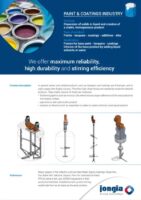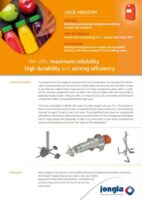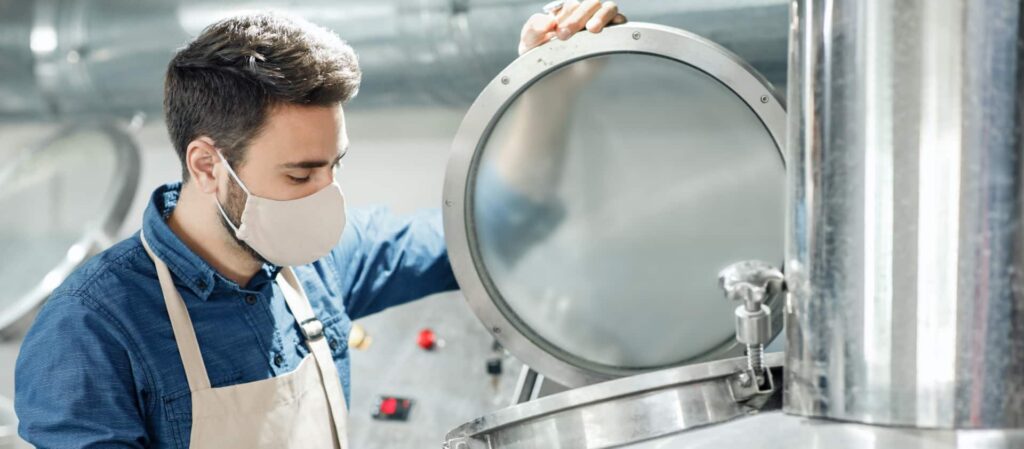
Mono fermentation
Everything you need to know about mono fermentation for industrial agitators
Mono fermentation, also known as single-stage digestion, is a common process used in anaerobic digestion systems to produce biogas from organic materials. This process involves the degradation of organic materials by a microbial group under anaerobic conditions, resulting in the production of biogas which is mainly composed of methane and carbon dioxide.
This process has become increasingly popular due to its potential to generate renewable energy and reduce greenhouse gas emissions. In this article, we will dive deeper in mono fermentation, its benefits, and how industrial agitators can improve the efficiency of the process.
What is Mono fermentation?
Mono fermentation is a single-stage anaerobic digestion process that combines all four stages of anaerobic digestion into one reactor. The process involves the degradation of organic materials by a diverse microbial community, resulting in the production of biogas.
The main advantage of mono fermentation over other anaerobic digestion processes is that it can handle a wide range of feedstock materials, including biodegradable waste, digestion of food waste, groene mineralen, animal manure, and crop residues. Additionally, mono fermentation systems are relatively simple, require less space, and have lower capital and operating costs than multi-stage anaerobic digestion systems.
Overview of anaerobic digestion process
Anaerobic digestion is a process that utilizes microorganisms to decompose organic materials in the absence of oxygen, resulting in the production of biogas. The anaerobic treatment process consists of four anaerobic digestion steps: hydrolysis, acidogenesis, acetogenesis, and methanogenesis.
During the hydrolysis stage, complex organic molecules are broken down into simpler organic molecules by enzymes produced by microorganisms. The simpler organic molecules are then further degraded into volatile fatty acids during the acidogenesis stage, where acidogenic bacteria play a critical role.
In the acetogenesis stage, the volatile fatty acids are converted into acetic acid, hydrogen, and carbon dioxide by acetogenic bacteria. Finally, in the methanogenesis stage, methanogenic bacteria convert the acetic acid, hydrogen, and carbon dioxide into methane and carbon dioxide, which make up the biogas.
The success of anaerobic treatment depends on the concentration of microorganisms and their ability to convert volatile solids into biogas. The concentration of micro-organisms in anaerobic digestion systems is affected by the nature of the feedstock, including its biodegradable material energy content, and the environmental conditions in the digestion tanks.
Thermophilic digestion systems, which operate at higher temperatures, are favored for digestion of pig manure, while mesophilic digestion systems are used for stable digestion processes and digestion on farms. An interesting part within the anaerobic treatment process is the production of methane.
Average methane production and fractions of methane
The average methane production of a particular feedstock material can vary depending on several factors, including the type of material, the level of pretreatment, the energy content, and the environmental conditions. The fractions of methane in biogas and other methane yield can also vary depending on the type of feedstock material and the level of pretreatment.
The methane formation can be optimized by improving the reactors for digestion through better feedstock management, improved reactor design, and optimization of the environmental conditions.
What are the benefits of mono fermentation?
Mono fermentation offers several benefits, including:
- Production of renewable energy: Mono fermentation offers conversion into biogas that can be used to generate renewable energy, reducing dependence on fossil fuels and greenhouse gas emissions.
- Reduction in waste: Mono fermentation reduces the amount of organic waste sent to landfills, which reduces methane emissions from landfills.
- Production of valuable fertilizers: Mono fermentation produces a nutrient-rich digestion of food waste that can be used as a fertilizer, improving soil health and reducing the need for synthetic fertilizers.
- Diverse feedstock: Mono fermentation can handle a wide range of feedstock materials, reducing waste and increasing the potential for renewable energy production.
- Lower capital and operating costs: Mono fermentation systems have lower capital and operating costs than multi-stage anaerobic digestion systems, making them more accessible to small-scale operators.
The challenges and limitations of mono fermentation
While mono fermentation offers several benefits, there are also some challenges and limitations associated with the process.
One of the challenges is the inhibition of the acidogenesis stage by ammonia and other harmful compounds present in the feedstock material. Ammonia inhibition can result in a decrease in conversion into biogas production and an increase in the production of organic acids such as propionic acid, which can accumulate and inhibit the methanogenesis stage.
Another challenge is the level of pretreatment required for certain feedstock materials such as food waste and sewage sludge. These materials may require additional pretreatment to break down complex organic molecules and increase the bioavailability of the material to the microbial community.
Finally, the adoption of mono vergisting may be limited by the level of putrescibility of the feedstock material. Highly putrescible materials such as food waste and slaughterhouse waste may be more suitable for other anaerobic digestion processes such as dry digestion or wet digestion with mesophilic conditions or thermophilic conditions.
Which factors affect mono fermentation?
Several factors can affect the efficiency of the mono fermentation process, including:
- Feedstock Material: The manure composition and properties of the feedstock material, such as its level of putrescibility, affect the rate of digestion and the methane yield.
- Level of Pretreatment: The level of pretreatment of the feedstock material, such as grinding and mixing, affects the accessibility of the microorganisms to the organic material, enhancing the rate of digestion and the methane yield.
- Environmental Conditions: Environmental conditions, such as temperature, heat demand, pH, moisture and energy content, affect the growth and activity of the micro – organisms, affecting the rate of digestion and the methane yield.
- Inhibition: Inhibition of the anaerobic treatment process can occur due to several factors, including high levels of ammonia, volatile fatty acids, and hydrogen sulfide, as well as the presence of harmful bacteria.
Connection industrial agitators and mono fermentation?
Industrial agitators play a critical role in the efficiency of mono fermentation systems. Agitators ensure that the feedstock material is thoroughly mixed with the microbial community, improving the degradation process and increasing biogas production.
Agitators also prevent the propionic acid accumulation of volatile solids in the reactor, ensuring that the microbial community has access to the feedstock material. Additionally, agitators can increase the reaction rate and reduce the retention time needed for complete degradation of the feedstock material.
In addition to improving the efficiency of the mono fermentation process, industrial agitators can also help reduce energy losses. Agitators can transfer waste heat and energy input from other processes to the mono fermentation reactor, reducing the energy input required for the stable digestion process.
Adoption rates of mono fermentation
Mono vergisting has been widely adopted in Europe, particularly in countries such as Germany, the Netherlands, and Denmark, where there is a strong emphasis on renewable energy production and waste reduction.
In the United States, adoption rates of mono vergisting have been slower due to factors such as lower energy prices and the availability of other renewable energy sources such as wind and solar. However, there has been an increase in interest in mono vergisting, particularly in the agricultural sector, where the process can help reduce the environmental impact of livestock operations.
Mono fermentation summarized
Mono fermentation offers a sustainable solution to the organic waste problem by converting waste into a renewable energy source and a nutrient-rich fertilizer. The adoption of mono fermentation has been increasing worldwide, driven by the need to reduce reliance on non-renewable sources of energy and promote sustainable agriculture. Industrial agitators can be used to enhance the efficiency of the mono fermentation process, promoting the transfer of mass and heat and preventing the methane formation and harmful bacteria formation. However, several factors can affect the efficiency of the mono fermentation process, and careful consideration of these factors is necessary to optimize the process.
Frequently Asked Questions
What is mono fermentation?
Mono fermentation is a single-stage anaerobic digestion process that combines all four stages of anaerobic digestion into one reactor. It breaks down organic materials using microbes, producing biogas, mainly methane and carbon dioxide. This method can handle various feedstocks like food waste, animal manure, and crop residues.
What are the benefits of mono fermentation?
Mono fermentation has several advantages including renewable energy production through biogas, waste reduction in landfills, nutrient-rich fertilizer production, and lower capital and operating costs compared to multi-stage systems. It also accommodates a diverse range of feedstock materials, enhancing renewable energy potential.
What factors affect mono fermentation efficiency?
Key factors include feedstock material properties, level of pretreatment, and environmental conditions like temperature and pH. Inhibition from high ammonia levels or harmful bacteria may also negatively impact the efficiency of mono fermentation and methane production during the process.
How do industrial agitators enhance mono fermentation?
Industrial agitators improve mono fermentation by ensuring thorough mixing of feedstock with microbes, which enhances degradation. They also prevent the accumulation of volatile solids, increase the reaction rate, and can reduce energy input by transferring waste heat to the reactor, promoting overall efficiency.
What challenges are associated with mono fermentation?
Challenges include ammonia and harmful compound inhibition during digestion, the need for pretreatment of certain feedstocks, and limitations in processing highly putrescible materials. These factors can affect the consistency and efficiency of biogas production during mono fermentation processes.
Contact our specialized team for all your questions

Tom Pruymboom
Sales Director
Area Worldwide

Bart Brouwer
Area Sales Manager
Area Worldwide
Technical Questions?

Sijko van der Veen
Application Engineer
Technical Specialist

Sijko van der Veen
Application Engineer
Technical Specialist
Popular Posts
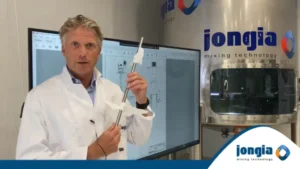
Tutorial: How does the BioFoil® propeller work?
The BioFoil® propeller is not just any propeller. It is Jongia Mixing Technology’s own design for the Biogas market. In the Biogas process gas is generated and disposed of from a tank filled with liquid (digestate). Recently, this technique has
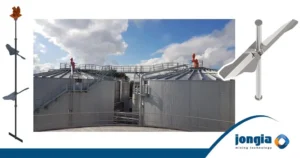
The development of a proprietary biogas agitator
Jongia Mixing Technology has been active in the biogas market since 2008. In the process regarding biogas, gas is generated and disposed of from a tank filled with fluid (digestate). This digestate mainly consists of organic waste. Over the last
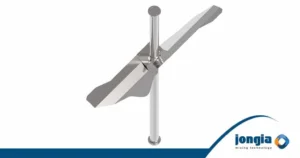
The BioFoil® propeller: an innovative stirring element
For mixing processes in every market Jongia Mixing Technology can recommend the hydrofoil propeller. This is a stirring element that is extremely product-friendly due to its shape. It’s a propeller with many possibilities because of its low energy consumption and




